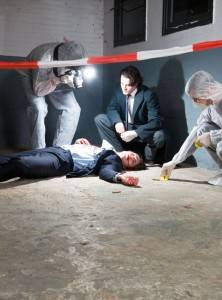Aiding and Abetting a Crime – Overview (Penal Code Section 31)
In legal terms, “aiding and abetting” means providing some kind of assistance in the commission of a crime. In other words, you can be charged for aiding and abetting by doing or saying something to further criminal activity. Aiding and abetting is also commonly known as “accomplice liability.” When you are an accomplice to a crime, you are also liable for being criminally complicit.California Penal Code Section 31 provides in relevant part: “All persons concerned in the commission of a crime…whether they directly commit the act constituting the offense, or aid and abet in its commission, or, not being present, have advised and encouraged its commission…are principals in any crime so committed.” Thus, those persons who are commonly referred to as “accessories” or “accomplices” as well as those who actually perpetrate the offense, are to be prosecuted, tried and punished as principals in California. (Penal Code Section 971.)
Terms Defined
The term “aider and abettor” is often used today to refer to principals other than the perpetrator, whether or not they are present at the commission of the offense.
The term “accessory before the fact” is used to describe those who aided in planning or by encouraging the commission of a crime before it was committed. For example, a person who participates in the planning of an armed robbery before it is committed is an “accessory before the fact”.
The term “accomplice” is a person who actively participates in the commission of a crime, even though they take no part in the actual criminal offense. For example, a person who acts as a lookout or as a getaway driver to an armed robbery is an “accomplice”.
The term “accessory after the fact” is reserved for those who have no role in the actual commission of an offense, but rather knowingly assist a person who has already committed a crime to avoid arrest and prosecution. For example, a person who assists the actual perpetrator of an armed robbery by hiding the stolen money for the perpetrator is an “accessory after the fact.”
Examples of Aiding and Abetting

You can be charged with aiding and abetting for contributing to the commission of a crime without actually committing the crime itself. Some common examples of aiding and abetting are:
- Acting as the “getaway” driver;
- Keeping a “lookout” while someone else commits an armed robbery;
- Creating an alibi for someone who has committed a criminal offense;
- Providing information to someone you know will use it to commit a crime;
- Directing a vehicle down a one-way street, knowing that vehicle is about to be carjacked; and/or
- Assisting in a kidnapping or rape.
It is important that you understand that, unless you have a legal duty to act, simply witnessing a crime being committed does not constitute criminal intent and does not make you liable for prosecution as an aider and abettor, regardless of whether harm could have been prevented if you had acted to prevent the crime in progress.
Elements of Aiding and Abetting a Crime
Aiding and abetting in the commission or attempted commission of a crime occurs whenever the following occurs:
- With knowledge of the unlawful purposes of the perpetrator; you
- Act;
- Aid;
- Promote;
- Encourage; or
- Instigate the commission of the crime; and
- Do so with intent or purpose of:
- Committing;
- Encouraging; or
- Facilitating the commission of the crime.
Prosecution for Aiding and Abetting a Crime

If you are accused of aiding and abetting in the commission or attempted commission of a crime, a prosecutor must be able to prove beyond a reasonable doubt the following elements:
- You had knowledge that the perpetrator intended to commit the crime in question;
- Prior to or during the crime being committed, you intended to assist, aid or encourage the perpetrator in the commission of the crime; and
- Your conduct or encouragement did in fact aid and abet the perpetrator’s commission of the crime.
Instigating, encouraging or promoting the crime is sufficient enough for you to face criminal charges. The test used in order to distinguish a principal from an accessory is whether the defendant independently contributed to the causing of the crime, rather than merely providing some form of limited help and encouragement, whether directly or indirectly.
Defenses to Aiding and Abetting a Crime
Our attorneys at Wallin & Klarich have successfully employed several defenses to a charge of aiding and abetting on behalf of our clients facing prosecution as an accomplice or an accessory to a crime. Some of these legal defenses include:
- No Participation: You did nothing to encourage, aid, or instigate the crime’s commission;
- Duress: You were coerced into participating in the crime under threat of immediate injury or death;
- False Accusation: You’ve been mistakenly identified as an aider and abettor;
- No Duty to Act: You were present during the crime’s commission but had no duty to prevent it;
- Withdrawal from Participation: You backed out prior to the crime’s commission and made your crime partners fully aware of your withdrawal;
- Accessory after the Fact: You had no role in the commission of the crime itself; rather, your involvement was limited to after the crime had already been committed. This defense is not significant enough to find you not guilty of this crime; however, it is significant enough to lessen the severity of your sentence.
Punishment and Sentencing for Aiding and Abetting a Crime

If you aid and abet another person during the commission of a crime, you may also be referred to as “an accessory before the fact.” However, under California law, there is no distinction between an accomplice and the principal perpetrator of the crime.
Generally, whether you are the person who commits, or attempts to commit the crime, or assists in its commission or attempt, either person faces the same penalties for that crime.
This is true for all crimes committed which resulted from “natural and probable consequences” of the intended illegal act.
Finally, “accessory after the fact” is a crime in itself, punishable as either a misdemeanor or as a felony.
Aiding and Abetting a Crime – Prosecution (Penal Code Section 31)
If you are accused of assisting someone else to perpetrate a crime, a prosecutor doesn’t actually charge you with a crime referred to as “aiding and abetting.” Instead, you can be charged with the crime(s) allegedly committed, under the legal theory that you acted as an accomplice or accessory.
To prove you guilty on a theory of aiding and abetting, a prosecutor must successfully demonstrate that you:
- Had knowledge of the unlawful purpose of the perpetrator;
- Acted with the intent or purpose of committing, encouraging or facilitating the commission of the offense; and
- By act or advice, aided, promoted, encouraged or instigated the commission of the crime.
Our attorneys at Wallin & Klarich want to explain how you can be convicted as an aider or abettor by identifying each of the elements that a prosecutor must prove in order to establish your given role in the crime’s commission or attempted commission.
1. You Had Knowledge

The first step in determining whether you aided and abetted a crime or its attempted commission is whether you possessed knowledge of the perpetrator’s unlawful intent.
Advanced knowledge of the unlawful purpose of the perpetrator is a critical element under the theory of accomplice liability. Whether you knew of the principal actor’s intent to commit a crime can be objectively determined.
Testimony from witnesses, including that of your co-defendants, may be sufficient to establish that you possessed knowledge of the perpetrator’s criminal intent.
2. You Acted with Intent
Criminal intent is legally defined as “the intent to commit a crime: malice, as evidenced by a criminal act; an intent to deprive or defraud the true owner of his property.”
Intent is a necessary element of a crime and means that you made a conscious decision to either injure someone or deprive that person of property. It is one of three categories of mens rea, a Latin term that refers to the establishment of a “guilty mind.”
Under the accomplice liability theory, a prosecutor must be able to prove that you acted willfully and knowingly in the planning, execution or instigation of a crime in a role other than that of the principal perpetrator.
3. You Aided or Instigated

Finally, a prosecutor must be able to prove that you did, in fact, offer some kind of assistance in the commission of a crime. You must have been involved with planning the crime (an accessory before the fact); or you played a role in its commission (an accomplice).
Your role as an accessory or an accomplice will be determined by several factors, including but not limited to the following:
- Presence at the scene of the crime,
- Companionship; and
- Conduct before or after the offense.
Keep in mind that you do not necessarily have to be present at the scene of a crime in order to be convicted of aiding and abetting. Your liability as an accomplice may be established given your role in planning or encouraging the execution of the actual crime.
Natural and Probable Consequences
Under certain circumstances, a person who is guilty of this crime also may be guilty of other crimes that were committed as a result of your aiding and abetting. To convict you of a related crime that was a likely result of the intended crime, a prosecutor must prove that:
1. You are guilty of the intended crime;
2. During the commission of the intended crime, a related offense was committed; and
3. Under all of the circumstances, a reasonable person in your position would have known that the related offense was a “natural and probable consequence” of the intended crime.
Aiding and Abetting a Crime – Defenses (Penal Code Section 31)
In this section, we identify and explain some of the defenses we may be able to raise on your behalf to defeat the prosecutor’s theory that you assisted, aided, or encouraged the commission of a criminal offense.
No Participation Defense

If you did nothing to encourage, aid, or instigate the crime’s commission, you cannot be held accountable for aiding and abetting a crime. There are many possibilities that could be misinterpreted as indicative of your participation.
For example: You are riding in a car with some friends on the way to a party. The driver stops at a convenience store with the intention of holding up the clerk. You wait in the car while he goes in and commits a robbery. You had no idea this would happen, nor were in any way involved in planning or encouraging the crime. You were, however, “present” at the scene.
You were, unfortunately, at the wrong place at the wrong time. However, merely being present during the commission of a crime is not sufficient to prove intent. Accordingly, your criminal defense attorney would be able to argue that because you had no idea that the driver had planned to engage in unlawful activity, you cannot be convicted of being an accessory to his or her crime.
Duress Defense
If you were compelled against your will to help someone commit a crime under immediate threat of serious bodily injury or death to yourself or to another person, you cannot be convicted of aiding and abetting.
This is known as duress, which is a legally viable defense in prosecutions for most crimes. If our attorneys can establish that you only assisted in the commission of a crime as a result of your being coerced by another person, you may be acquitted of these charges.
However, you cannot claim coercion if you were only threatened with minor injury, property damage, or damage to your reputation. Additionally, duress is not available as a defense to murder, which requires the element of malice aforethought, or a pre-determined intent to kill someone.
For duress to succeed as a defense to aiding and abetting, the threat made against you must be “immediate”, “credible” and involve serious injury or death.
False Accusation Defense

Oftentimes a criminal wishing to avoid liability for his or her wrongdoing will try to point the finger at you. Aiding and abetting doesn’t require any physical proof, but merely testimony that you were somehow involved. Thus, it is easy to falsely accuse someone of being an accessory.
Additionally, motives for false accusations may include anger, jealousy and profit. For example, a wife, angered by her husband’s infidelity and jealous of the affair, may falsely accuse him of being an accomplice to a rape, just to exact some revenge.
If you’ve been mistakenly identified as someone who facilitated the commission of a crime, our attorneys will be able to argue that you’ve been falsely accused which may prove your innocence.
No Duty to Act Defense
Simply knowing that a crime is going to be committed, or being present during its commission does not impose upon you an obligation to prevent it from occurring under most circumstances.
Otherwise, you are under no legal obligation to prevent a crime from occurring. Mere advance knowledge of its plan is typically insufficient to convict you of aiding and abetting.
Withdrawal from Participation Defense
You may have a valid defense to aiding and abetting if your criminal defense attorney can show that your liability as an aider and abettor ended prior to the commission of the crime(s) charged. To rely on this defense, you must be able to demonstrate that you:
- Notified the other people involved in the crime of your intention to withdraw from participation; and
- Did everything in your power to prevent the crime from being committed.
A jury must decide beyond reasonable doubt whether or not you satisfied both of the above conditions.
It is not enough that you simply walk away from the crime. Most likely, you would have had to take affirmative steps to show an intent to prevent, such as informing a law enforcement agency of the fact that a crime was about to be committed.
Accessory after the Fact Defense

Accessories after the fact are not subject to the same treatment as accomplices to a crime. If you do participate in the commission of a crime, but only after it has been committed, you may have a legal defense to aiding and abetting under the accomplice liability theory. If so, you cannot be convicted of the same crime as a principal.
For example, if robbery was the underlying crime, but your role was limited to stashing the stolen cash after it was taken, you may be able to avoid being convicted of the robbery itself. A first-degree robbery conviction carries up to nine years in prison and is a strike under California’s Three Strikes law.
However, you could face prosecution for the separate crime of what is generally considered “obstruction of justice” (See Penal Code Section 32). Although you can still be punished if convicted as an accessory after the fact, the penalties you face are likely to be much less than if convicted as an accomplice to the underlying crime.
Aiding and Abetting a Crime – Sentencing and Punishment (Penal Code Section 31)
If you aid and abet another person during the commission of a crime, you may also be referred to as an “accessory.” However, under California law, there is no distinction between an accessory and the principal perpetrator of the crime in terms of sentencing.
Generally, whether you are the person who commits, or attempts to commit the crime, or assists in its commission or attempt, you face the same penalties for that crime as if you were the actual perpetrator.
For example: If you acted as a “lookout” during a home invasion robbery involving at least two other principals, even though you never stepped foot inside the residence being robbed, you are still subject to a sentence of up to nine years in prison.
Pursuant to California Penal Code Section 32, if you harbor, aid or conceal a person who you know has committed a crime, you are an accessory to that felony. Acting as an accessory after the fact is a “wobbler” offense – meaning a prosecutor has discretion to charge you with either a misdemeanor or a felony. A charge of accessory after the fact is punishable as follows:
- Up to a $5,000 fine; and/or
- Up to one year in jail if you are convicted of a misdemeanor; or
- Up to three years in jail if you are convicted of a felony.
Principal Acquitted or Convicted of a Lesser Offense

A jury must decide that a principal perpetrator committed the crime in which you aided and abetted. However, whether that person is acquitted or convicted of a lesser crime separate from you does not prevent your conviction as an aider and abettor.
This means that you can still be convicted as an accomplice to a crime even if the person standing trial for being principally responsible is not proven guilty of personally committing the crime.
Natural and Probable Consequences
“Natural and probable consequences” are foreseeable consequences that a reasonable person would know is likely to happen if nothing unusual intervenes.
Which means, if you help someone to commit a particular crime – such as armed robbery – and that person ends up displaying or discharging a firearm intended to be used during the course of the robbery, you are both subject to being prosecuted for the robbery as well as for firearms-related charges.
A jury must consider all of the circumstances established by the evidence when instructed on a finding of natural and probable consequences.
Accomplice Liability in Murder Charges

The California Supreme Court has recognized that in certain circumstances, an aider and abettor may have greater criminal liability in homicide-related crimes than the actual perpetrator.
When a person, with the mental state necessary for an aider and abettor, helps or induces another to kill, that person’s guilt is determined by the combined acts of all the participants as well as that person’s own mens rea.
If your mens rea – the requisite intent that must be formed in the mind to commit a crime – is more culpable than another’s, your liability in the killing may be greater, even if the other is deemed the actual killer.
For example: two defendants during a robbery (a perpetrator and an accessory) kill someone in a drive-by shooting during their escape. The actual perpetrator is able to prove self-defense, and may have his or her charge reduced to voluntary manslaughter or even dismissed. On the other hand, if the aider and abettor is proven to have fired his or her weapon with intent to kill, he or she can be found guilty of committing murder.
Aiding and Abetting a Crime – FAQ’s (Penal Code Section 31)
1. Is aiding and abetting a crime?
Technically, aiding and abetting is not a crime in itself. Rather, it is a legal theory that you acted purposely to make a crime possible. As an aider and abettor, you intentionally help plan, execute or encourage in the commission of a crime. As result, you can be charged with whatever crime or crimes were intended to be committed.
2. How does a prosecutor prove that I am guilty of aiding and abetting?
To prove you guilty on a theory of aiding and abetting, a prosecutor must demonstrate three things: That you knew of someone’s unlawful purpose; you acted with the intent or purpose of committing or encouraging the commission of a crime; and that your actions did, in fact, aid or promote in the commission of the offense.
3. If I help someone commit a crime, and he or she commits another crime in the process, can I be convicted for both?
This is certainly possible. The court can give the jury an instruction known as “natural and probable consequences.” This means you may face conviction for any crimes resulting from the intended crime if a reasonable person could have foreseen that the related crime was likely to have occurred.
4. What punishment do I face if I am accused of aiding and abetting?
Generally, as an accessory or an accomplice to a crime, you face the same punishment as if you personally committed the offense. In fact, in a homicide-related case, in some circumstances you could face even greater liability than the actual killer.
5. Can I be prosecuted for helping someone after he or she commits a crime?
Yes. If you assist someone after committing a crime to avoid being arrested and brought to justice, you can be criminally prosecuted as “an accessory after the fact.” If convicted, you could be sent to jail, order to pay up to a $5,000 fine, or both.
Wallin & Klarich Can Help You Fight Charges of Aiding and Abetting a Crime

If you or someone you care about has been accused of aiding and abetting a crime, contact our experienced criminal defense attorneys at Wallin & Klarich today. You can be charged and prosecuted just as if you personally committed the underlying crime or crimes.
With over 40 years of experience, our attorneys at Wallin & Klarich have the skills and knowledge to successfully defend you against serious charges of aiding to a crime. We are committed to providing you with the personal attention you deserve and expect to help you overcome this difficult situation.
With offices in Los Angeles, Sherman Oaks, Torrance, Tustin, San Diego, Riverside, San Bernardino, Ventura, West Covina and Victorville, our attorneys at Wallin & Klarich are available 24 hours a day, 7 days a week to provide you with the very best legal representation. We will employ every available strategy to help you get the best result possible in your case.
Call us today at (877) 4-NO-JAIL or (877) 466-5245 for a free telephone consultation. We will get through this together.

